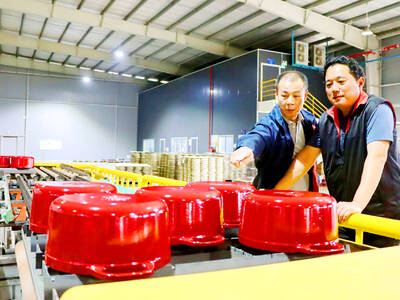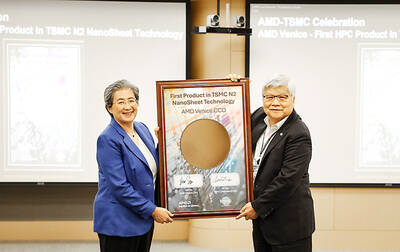The phrase is used so often it has become a cliche: “Haiti is the poorest country in the Americas” — but even so, the sentiment fails to capture the stark reality of the Caribbean nation five years after it was leveled by a devastating earthquake.
Haiti’s per capita GDP is the 209th-lowest in the world, behind that of Sierra Leone, North Korea or Bangladesh. The amount of money that Haitians living abroad send home is five times higher than the value that the country’s exports generate.
The 2010 earthquake and ensuing cholera epidemic were only the latest blows to a Caribbean republic that suffered brutal colonialism — France forced its slaves to pay reparations for rising against it — and domestic misrule.
Despite all this, some see potential in the country: Haiti is a low-wage economy lying just south of the huge US market and just north of the emerging economies of Latin America — some have even spoken of its becoming a manufacturing “Taiwan of the Caribbean.”
If that sounds implausible given the state of the country five years after the Jan. 12, 2010, disaster, no one has told Surtab SA, a firm that opened in June 2013 to produce own-brand tablets in Port-au-Prince that run Google Inc’s Android operating system.
The firm boasts that since opening, it has expanded production to 20,000 units last year for the local, Caribbean and African markets, and now provides skilled employment for 60 Haitian workers, despite the stigma of its location.
General manager Diderot Musset said Surtab hopes to triple production this year, but admits that even Haitians are suspicious of the firm’s claims.
“Until they get here and look at the installations, they don’t believe that we are really doing this in Haiti,” he said. “We even had workers who would go home and say that’s what they’re doing, and people not believing them, you know: ‘You’re not making this.’”
“So they had to bring a tablet home and say: ‘Okay, yeah, I made this,’ and still someone would ask: ‘Can you disassemble and reassemble it right now?’” he added.
It is not just a question of perception — Haiti does present severe practical challenges for would-be entrepreneurs, especially in manufacturing:
As a reporter was touring the Surtab plant, with its high-tech “cleanroom” for assembling the wireless devices that give Haitians a cheap means to get online, the power from the nation’s rickety electric grid cut out.
About half of the Haitian government’s income comes from foreign donors of one sort or another and the promised flood of aid in the wake of the 2010 quake never fully materialized or was used up quickly in emergency measures.
However, there has been a recovery — despite an ongoing political crisis — and Haitian President Michel Martelly’s government is bullish about economic opportunity.
The government likes to show off infrastructure projects like the new airport in Cap Haitien it hopes will attract tourists and Haitians proudly show off local products like the Prestige beer flowing from the capital’s rebuilt brewery.
Is this enough of a basis to dream of replacing the worn-out “poorest country” tag with a new “Taiwan of the Caribbean” cliche?
Not so fast. Low-wage manufacturing jobs allow employees to drag some lucky families out of penury, but 80 percent of Haitians live below the poverty line and a modern mixed economy needs a finance and service sector
Robert Maguire, a former US Department of State analyst at the Elliott School of International Affairs, is cautious about the Surtab example.
“I’m not sure that an economy based upon just people sitting in a factory all of the time is a real way to develop a country, absent other elements of the economy,” he said. “It can be a part of the solution, but too often I think it’s seen as the solution.”
Surtab is proud that its performance-based salaries come out at more than one-and-a-half times Haiti’s minimum wage, but its workers grumble that it is not always a steady source of income.
“Compared between when the production line is going and when it’s not, that’s two different things,” Farah Tilus said. “Surtab pays a base salary that’s very low — seriously low — but they offer an opportunity that we can ... make the most of.”
Nevertheless, after all the country has been through, there is a certain pride that comes from seeing each tablet bearing the stamp: “Made in Haiti.”

UNCERTAINTY: Innolux activated a stringent supply chain management mechanism, as it did during the COVID-19 pandemic, to ensure optimal inventory levels for customers Flat-panel display makers AUO Corp (友達) and Innolux Corp (群創) yesterday said that about 12 to 20 percent of their display business is at risk of potential US tariffs and that they would relocate production or shipment destinations to mitigate the levies’ effects. US tariffs would have a direct impact of US$200 million on AUO’s revenue, company chairman Paul Peng (彭雙浪) told reporters on the sidelines of the Touch Taiwan trade show in Taipei yesterday. That would make up about 12 percent of the company’s overall revenue. To cope with the tariff uncertainty, AUO plans to allocate its production to manufacturing facilities in

TAKING STOCK: A Taiwanese cookware firm in Vietnam urged customers to assess inventory or place orders early so shipments can reach the US while tariffs are paused Taiwanese businesses in Vietnam are exploring alternatives after the White House imposed a 46 percent import duty on Vietnamese goods, following US President Donald Trump’s announcement of “reciprocal” tariffs on the US’ trading partners. Lo Shih-liang (羅世良), chairman of Brico Industry Co (裕茂工業), a Taiwanese company that manufactures cast iron cookware and stove components in Vietnam, said that more than 40 percent of his business was tied to the US market, describing the constant US policy shifts as an emotional roller coaster. “I work during the day and stay up all night watching the news. I’ve been following US news until 3am

COLLABORATION: Given Taiwan’s key position in global supply chains, the US firm is discussing strategies with local partners and clients to deal with global uncertainties Advanced Micro Devices Inc (AMD) yesterday said it is meeting with local ecosystem partners, including Taiwan Semiconductor Manufacturing Co (TSMC, 台積電), to discuss strategies, including long-term manufacturing, to navigate uncertainties such as US tariffs, as Taiwan occupies an important position in global supply chains. AMD chief executive officer Lisa Su (蘇姿丰) told reporters that Taiwan is an important part of the chip designer’s ecosystem and she is discussing with partners and customers in Taiwan to forge strong collaborations on different areas during this critical period. AMD has just become the first artificial-intelligence (AI) server chip customer of TSMC to utilize its advanced

Six years ago, LVMH’s billionaire CEO Bernard Arnault and US President Donald Trump cut the blue ribbon on a factory in rural Texas that would make designer handbags for Louis Vuitton, one of the world’s best-known luxury brands. However, since the high-profile opening, the factory has faced a host of problems limiting production, 11 former Louis Vuitton employees said. The site has consistently ranked among the worst-performing for Louis Vuitton globally, “significantly” underperforming other facilities, said three former Louis Vuitton workers and a senior industry source, who cited internal rankings shared with staff. The plant’s problems — which have not